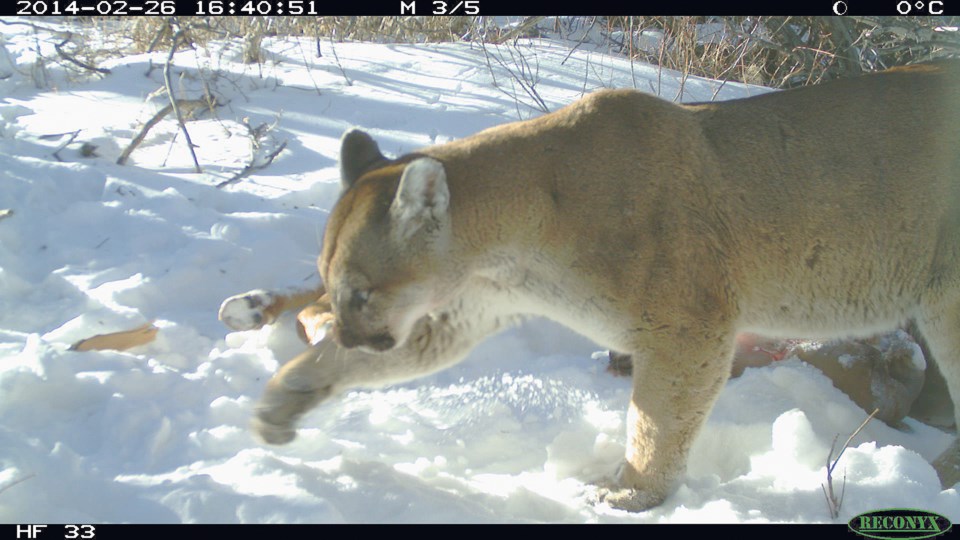CANMORE – Cougars are thought to be hunting newborn elk in the valley bottom in and around Canmore.
Several cougar sightings, including one on the island by the power plant on the Bow River in Canmore, have been reported in recent weeks.
While cougars haven’t been seen actually eating elk calves, wildlife officials suspect that’s what they’re doing given it is elk calving season until at least the end of June.
“It’s not unreasonable to think that they could be there looking for elk calves, but it also is an area that we’ve seen wildlife move through before,” said Jay Honeyman, a human-wildlife conflict specialist with Alberta Environment and Parks (AEP).
“We’ve also had bears in that area during the calving season, and it’s a possibility that they might be there for the calves, but we haven’t confirmed a bear killing a calf.”
Efficient ambush hunters, cougars are solitary and can be active any time of day, but most often hunt at dusk, night and dawn. They eat deer, elk and bighorn sheep, but they will prey on feral rabbits and have attacked and killed pet dogs in Canmore.
Last week, Honeyman said there was a report of a black bear chasing an elk through a residential neighbourhood in the Silvertip area on the north side of the valley – but was unsuccessful in the hunt.
“Obviously it happens,” he said.
Cougars are habitat generalists, making them among the most adaptable and wide-ranging. Their range extends from northern Alberta and British Columbia to the southern tip of South America.
Attacks on humans are extremely rare because cougars do not typically see humans as prey.
According to an AEP report, underweight and young, inexperienced cougars appear more likely to attack people. The same report indicates there have been been three to four attacks per year on people in North America since the beginning of the 1990s.
Alberta’s only fatality occurred in 2001, when a cougar killed Canmore’s Frances Frost, 30, as she was cross-country skiing near Lake Minnewanka in Banff National Park in January.
According to data from AEP, there were 381 cougar occurrences from 2000-19 within the Bow Valley, stretching from the east boundary of Banff National Park to Kananaskis River, and 284 of these occurred within Canmore.
Of the total occurrences, 201 were in residential areas, again mostly in Canmore.
There are so-called hot spots on both sides of the valley, including Eagle Terrace and Cougar Creek on the north and the Peaks of Grassi and Rundleview neighbourhoods on the south side.
Of the 381 occurrences, 240 were cougars seen travelling through residential areas and urban green spaces in the valley, with 32 of those involving cougars hunting wildlife or feeding on carcasses in residential areas and urban green spaces.
Nick de Ruyter, Bow Valley WildSmart’s program director, said elk calves are a fairly easy meal for cougars.
“It is highly likely that the elk calving has drawn them a bit closer in, looking for a nice easy meal,” he said, adding no one has reported seeing a cougar hunting calves.
“At this this time of year, if all of a sudden now we see cougars down in the valley bottom along the river, it’s quite likely that they would be attracted by newborn calves.”
To avoid a cougar encounter, people are encouraged to travel in groups, be especially cautious when travelling at dawn and dusk, travel slowly if cycling or jogging, make noise, and leave the area if you see or smell a dead animal.
Keeping pets on leash is also another important way Bow Valley WildSmart suggests can help prevent a cougar encounter.
Last fall, a cougar was shot and killed by conservation officers after it killed one dog and tried attacking another in the Ha-Ling Peak Trail and East End of Rundle areas in early October.
The first encounter involved a cougar approaching woman with her dog, which was on-leash. She was able to scare off the wild cat by using bear spray at a range of less than one metre.
While wildlife officers were investigating this incident, another call came in about a cougar attacking and snatching an off-leash dog. The cougar was later found eating the dog and was shot and killed.
In addition to keeping dogs on leash at all times, Bow Valley WildSmart indicates keeping young children close by is always a good plan to avoid a cougar encounter as well.
“Kids running running around and pets running around can really attract the attention of a cougar because their movements are often erratic, and they’re often running,” de Ruyter said.
“That just catches a predator’s eye; they are predators and they know it could be prey, so try to minimize that by keeping kids close and keeping pets on a leash and that should hopefully help reduce the risk of encounters.”
Wildlife officials continue to push home the important of carrying bear spray and knowing how to use it, which could save a life in an encounter with a bear or cougar, or stop a charging elk in its tracks.
“If you’re out hiking or biking – carry bear spray, carry bear spray, carry bear spray,” said Honeyman.
“Be alert and be aware that there’s multiple species of wildlife in the valley.”




